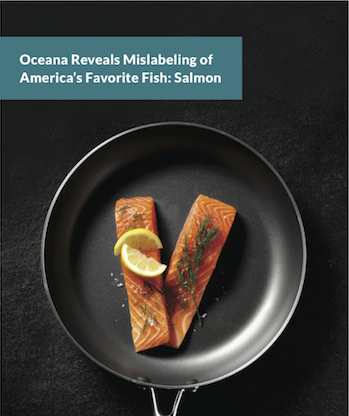Last week, Oceana released yet another well-publicized report alleging widespread fish fraud (New Oceana study reveals scary news about America’s favorite fish). This time, the target was wild salmon and the big headlines heralded 48 percent mislabeling.
 The “study” took a total of 466 samples in two separate surveys between 2012 and 2014. That’s an average of 233 samples per survey from grocery stores and restaurants. If they were split evenly between the two markets, then each survey sampled about 100 restaurants and 100 grocery stores. According to the Food Marketing Institute, there were 37,716 supermarkets with more than $2 million in annual sales in 2014, so that’s only the large retailers, which makes Oceana’s sample size 0.2 percent and 0.01 percent of the 1 million restaurants in the country.
The “study” took a total of 466 samples in two separate surveys between 2012 and 2014. That’s an average of 233 samples per survey from grocery stores and restaurants. If they were split evenly between the two markets, then each survey sampled about 100 restaurants and 100 grocery stores. According to the Food Marketing Institute, there were 37,716 supermarkets with more than $2 million in annual sales in 2014, so that’s only the large retailers, which makes Oceana’s sample size 0.2 percent and 0.01 percent of the 1 million restaurants in the country.
Statistically speaking, this is nowhere near an adequate sample size. The reason number crunchers like a representative sample is because without a wide enough range, it’s easy for the samplers to target retailers (intentionally or not) who might be more likely to mislabel. For example, outlets in poorer neighborhoods where consistent staffing might more difficult or in areas where English is not the first language.
Oceana claims that off-season (winter) restaurant salmon samples were mislabeled as much as 48 percent of the time. However, that doesn’t mean 48 percent of the salmon labeled as wild was actually farmed. To get to their 48 percent figure, Oceana included one type of wild salmon labeled as another type of wild salmon. So the error of selling wild silver under the name wild king was lumped in with the substitution of farmed for wild. Because most of the mislabeling happened in the off season, Oceana advises that the best way to improve your chances of being served authentically wild salmon is to eat it in season. But I disagree.
I know other food segments deal with these kinds of reports — how often are Kobe and grass-fed beef replaced with cheaper substitutes? But the biggest hurdle we face in the seafood business is that Americans are already a little intimidated by seafood. There are so many kinds, different cuts, different seasons. How does one choose? And many are intimidated about preparation, as well.
So when big reports come out with words like “scary” in the title (is it really frightening to get farmed salmon vs. wild every once in a while? I’m no big fan of farmed salmon, but I’m not afraid of it), they do little to build already flagging consumer confidence.
I realize Oceana is just doing its duty. As an NGO, they are compelled to make big splashy campaigns to get eyes on paper and raise money so they can keep making big splashy campaigns. But as an advocate for the industry, I can’t ignore a report that does little to further consumer education.
Look at what farm-to-table menus and farmers markets have done for our cultural culinary aptitude. We are regularly eating food that would have been considered bizarre just a few years ago. If kale can be a massive consumer hit, wild salmon should be sold out in every possible application — fresh, frozen, canned and smoked.
To add insult to injury, Oceana published the report during national seafood month. Not exactly a celebratory moment.
One point on which I wholeheartedly agree with Oceana is that the first way to prevent from being duped is to ask questions about what you’re buying. I ask a lot of questions. I feel like it’s my duty to consumers who might not know what questions to ask. If the purveyors know you’re interested in the origins of your seafood, they might be more careful in labeling in the first place.
Read more about Oceana >>







